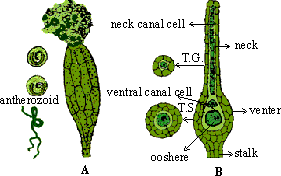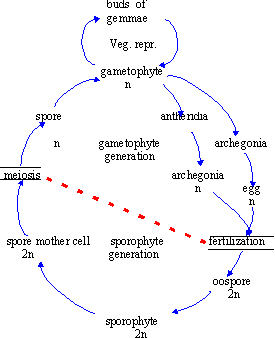|
PinkMonkey Online Study Guide-Biology
Mosses
A moss plant begins as a filamentous, green, body called
a protonema which produces buds giving rise to the mature moss
plants.
The moss plant is a gametophyte measuring about 2 to 3 cm in height. It is differentiated into stem-like (cauloid) and leaf-like (phylloid) appendages. There are no true roots. The plant is fixed to the substratum by multicellular rhizoids. The leaf-like appendages are sessile, spirally arranged on a short stem forming a cluster or rosette at the apex.
Reproduction is mainly sexual, asexual and at times vegetative.
At maturity antheridia (male) are borne at the tip of the main
branch surrounded by a rosette of leaves, and archegonia (female)
are borne at the tip of lateral branch surrounded by a rosette of leaves.
The antheridia are club-shaped. At maturity they produce biflagellate,
coiled antherozoids. The archegonia are flask-shaped, each containing
one large female gamete called an egg at its broad base. Fertilization
takes place in presence of water by the process of chemotaxis,
i.e. under the influence of a chemical substance released by the archegonium.
The resulting zygote is the beginning of a diploid sporophyte.

Figure 14.35 A. Antheridium of moss
B. Archegonium of moss
The sporophyte is a leafless structure living
as a semiparasite on the gametophyte. It consists of a foot which
is embedded in the gametophyte and absorbs nourishment, the middle slender,
long seta which is used for dispersal of spores, and the apical pear-shaped
capsule provided with a lid. It produces haploid spores at maturity.
In dry weather, the lid breaks open and the spores are dispersed by wind.
Under suitable conditions, a spore germinates to form a protonema. The
latter produces buds which give rise to gametophytes, thus completing
the life-cycle.
Life-cycle pattern : The life-cycle shows morphologically
distinct alternation of generations in which gametophyte is the
dominant, independent stage and the sporophyte is a semiparasite
or parasite on the gametophyte.
The plant is a gametophyte which at maturity produces
haploid male and female gametes. The male and female gametes fuse to form
a diploid zygote or oospore. The latter develops into a sporophyte. Sporophyte
at maturity produces haploid spores which are released in dry weather.
Spore germination produces a gametophyte. This successive appearance of
two generations alternately one after the other (G-S-G-S) in the life-cycle
is called alternation of generations.

Figure 14.36 Life-cycle pattern (Bryophyta)
Role of bryophytes in nature : (i) Bryophytes provide food for herbivores, birds and other animals. (ii) Bog mosses and peat mosses are used as water absorbing and water retaining material in seed beds and green houses. (iii) They are also used as shock absorbing (packing) material for shipment. (iv) Dead and decaying mosses form humus which increases fertility of soil.
|